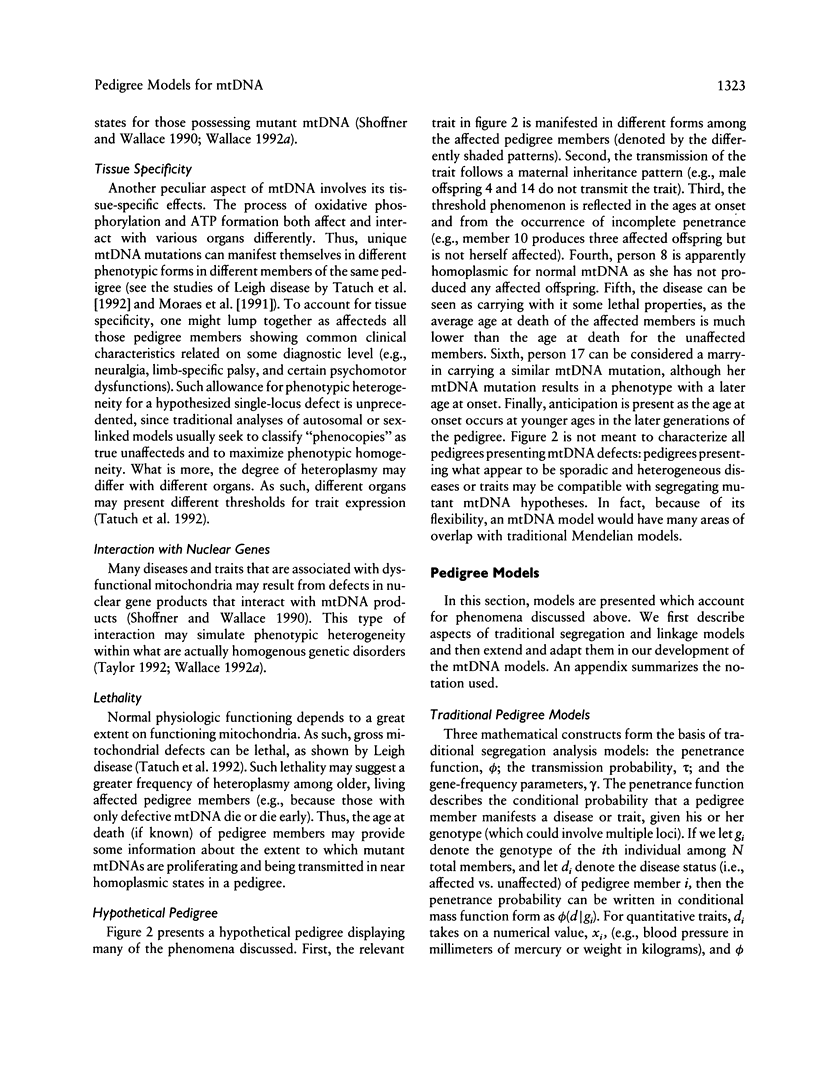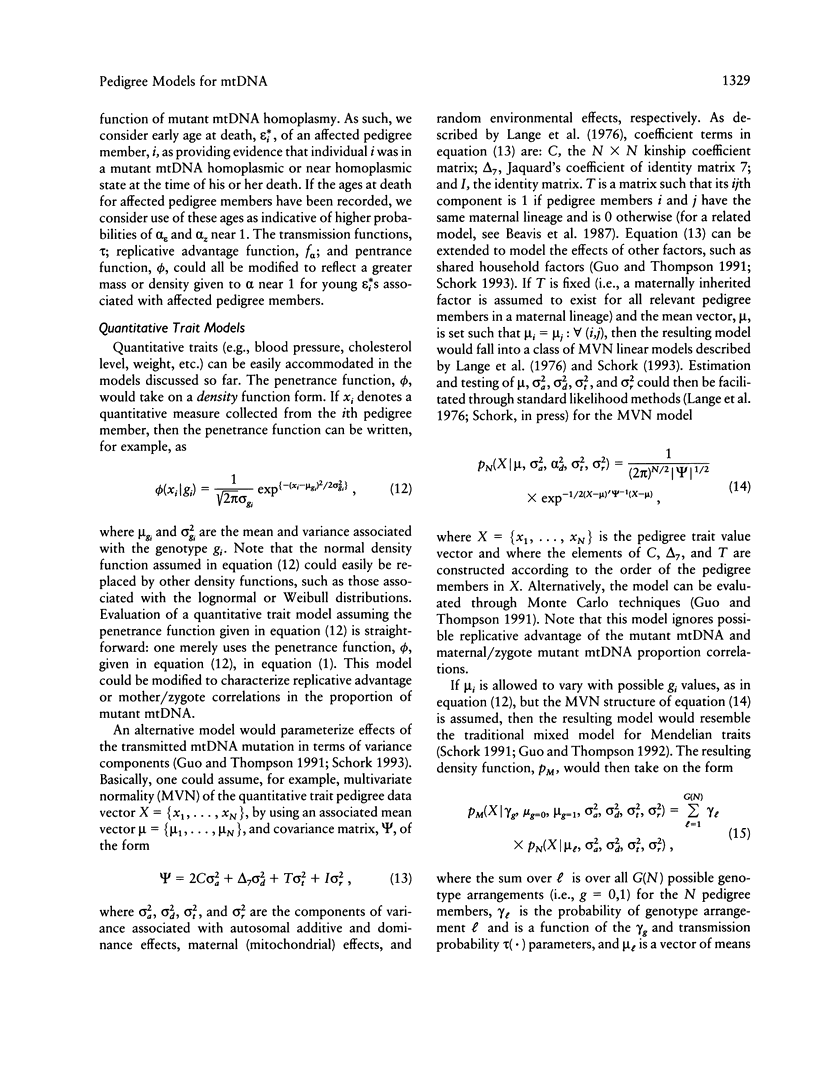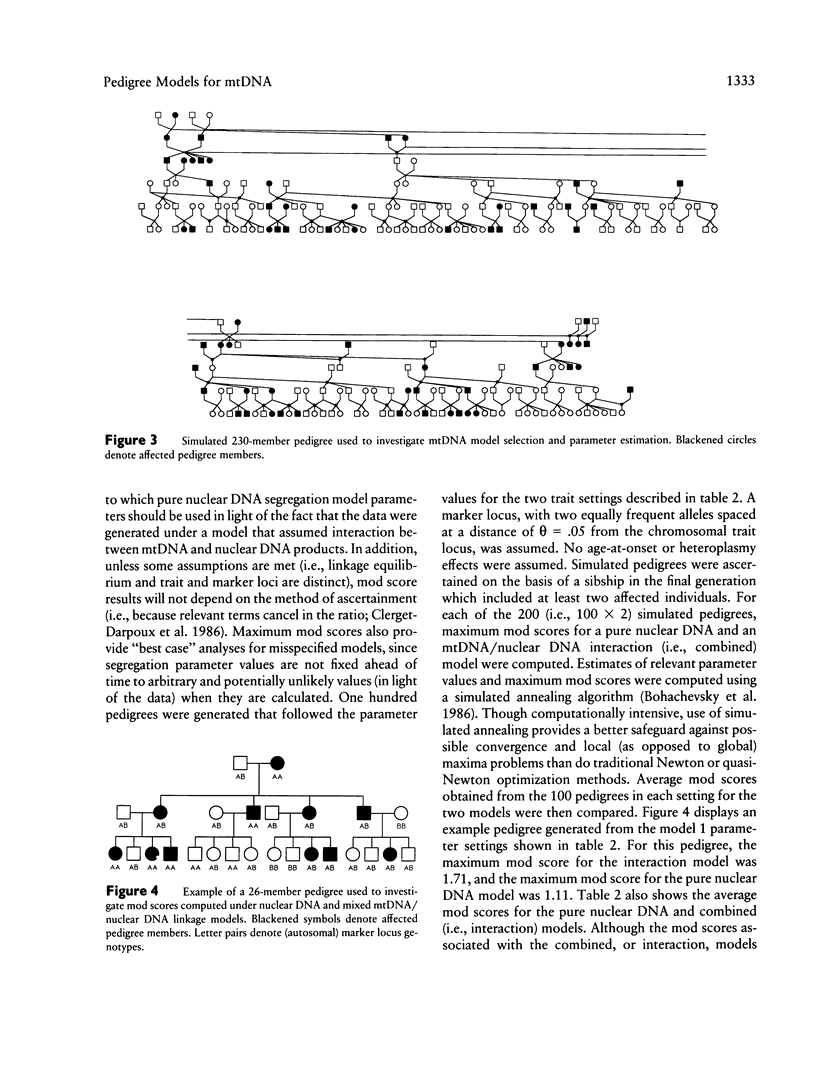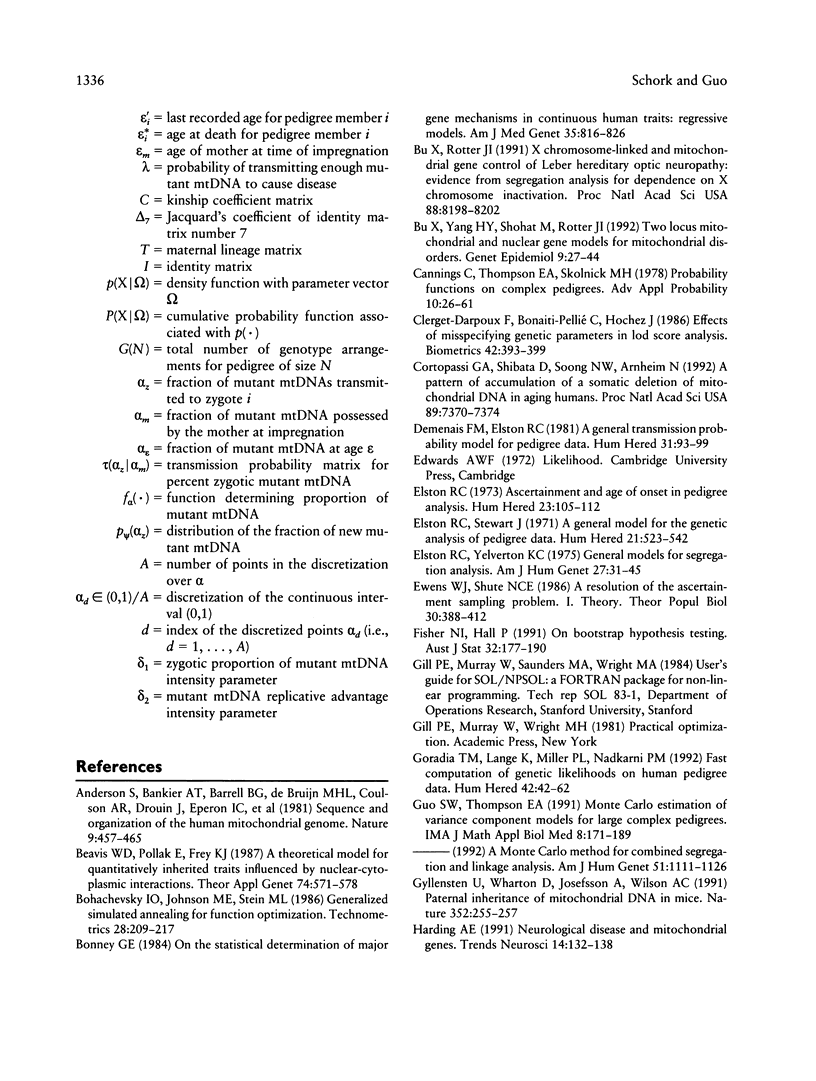Abstract
Recent biochemical and molecular-genetic discoveries concerning variations in human mtDNA have suggested a role for mtDNA mutations in a number of human traits and disorders. Although the importance of these discoveries cannot be emphasized enough, the complex natures of mitochondrial biogenesis, mutant mtDNA phenotype expression, and the maternal inheritance pattern exhibited by mtDNA transmission make it difficult to develop models that can be used routinely in pedigree analyses to quantify and test hypotheses about the role of mtDNA in the expression of a trait. In the present paper, we describe complexities inherent in mitochondrial biogenesis and genetic transmission and show how these complexities can be incorporated into appropriate mathematical models. We offer a variety of likelihood-based models which account for the complexities discussed. The derivation of our models is meant to stimulate the construction of statistical tests for putative mtDNA contribution to a trait. Results of simulation studies which make use of the proposed models are described. The results of the simulation studies suggest that, although pedigree models of mtDNA effects can be reliable, success in mapping chromosomal determinants of a trait does not preclude the possibility that mtDNA determinants exists for the trait as well. Shortcomings inherent in the proposed models are described in an effort to expose areas in need of additional research.
Full text
PDF

















Selected References
These references are in PubMed. This may not be the complete list of references from this article.
- Anderson S., Bankier A. T., Barrell B. G., de Bruijn M. H., Coulson A. R., Drouin J., Eperon I. C., Nierlich D. P., Roe B. A., Sanger F. Sequence and organization of the human mitochondrial genome. Nature. 1981 Apr 9;290(5806):457–465. doi: 10.1038/290457a0. [DOI] [PubMed] [Google Scholar]
- Bu X. D., Rotter J. I. X chromosome-linked and mitochondrial gene control of Leber hereditary optic neuropathy: evidence from segregation analysis for dependence on X chromosome inactivation. Proc Natl Acad Sci U S A. 1991 Sep 15;88(18):8198–8202. doi: 10.1073/pnas.88.18.8198. [DOI] [PMC free article] [PubMed] [Google Scholar]
- Bu X., Yang H. Y., Shohat M., Rotter J. I. Two-locus mitochondrial and nuclear gene models for mitochondrial disorders. Genet Epidemiol. 1992;9(1):27–44. doi: 10.1002/gepi.1370090105. [DOI] [PubMed] [Google Scholar]
- Clerget-Darpoux F., Bonaïti-Pellié C., Hochez J. Effects of misspecifying genetic parameters in lod score analysis. Biometrics. 1986 Jun;42(2):393–399. [PubMed] [Google Scholar]
- Cortopassi G. A., Shibata D., Soong N. W., Arnheim N. A pattern of accumulation of a somatic deletion of mitochondrial DNA in aging human tissues. Proc Natl Acad Sci U S A. 1992 Aug 15;89(16):7370–7374. doi: 10.1073/pnas.89.16.7370. [DOI] [PMC free article] [PubMed] [Google Scholar]
- Demenais F. M., Elston R. C. A general transmission probability model for pedigree data. Hum Hered. 1981;31(2):93–99. doi: 10.1159/000153185. [DOI] [PubMed] [Google Scholar]
- Elston R. C., Stewart J. A general model for the genetic analysis of pedigree data. Hum Hered. 1971;21(6):523–542. doi: 10.1159/000152448. [DOI] [PubMed] [Google Scholar]
- Elston R. C., Yelverton K. C. General models for segregation analysis. Am J Hum Genet. 1975 Jan;27(1):31–45. [PMC free article] [PubMed] [Google Scholar]
- Ewens W. J., Shute N. C. A resolution of the ascertainment sampling problem. I. Theory. Theor Popul Biol. 1986 Dec;30(3):388–412. doi: 10.1016/0040-5809(86)90042-0. [DOI] [PubMed] [Google Scholar]
- Guo S. W., Thompson E. A. Monte Carlo estimation of variance component models for large complex pedigrees. IMA J Math Appl Med Biol. 1991;8(3):171–189. doi: 10.1093/imammb/8.3.171. [DOI] [PubMed] [Google Scholar]
- Gyllensten U., Wharton D., Josefsson A., Wilson A. C. Paternal inheritance of mitochondrial DNA in mice. Nature. 1991 Jul 18;352(6332):255–257. doi: 10.1038/352255a0. [DOI] [PubMed] [Google Scholar]
- Harding A. E. Neurological disease and mitochondrial genes. Trends Neurosci. 1991 Apr;14(4):132–138. doi: 10.1016/0166-2236(91)90081-5. [DOI] [PubMed] [Google Scholar]
- Holt I. J., Harding A. E., Petty R. K., Morgan-Hughes J. A. A new mitochondrial disease associated with mitochondrial DNA heteroplasmy. Am J Hum Genet. 1990 Mar;46(3):428–433. [PMC free article] [PubMed] [Google Scholar]
- Holt I. J., Miller D. H., Harding A. E. Genetic heterogeneity and mitochondrial DNA heteroplasmy in Leber's hereditary optic neuropathy. J Med Genet. 1989 Dec;26(12):739–743. doi: 10.1136/jmg.26.12.739. [DOI] [PMC free article] [PubMed] [Google Scholar]
- Moraes C. T., Shanske S., Tritschler H. J., Aprille J. R., Andreetta F., Bonilla E., Schon E. A., DiMauro S. mtDNA depletion with variable tissue expression: a novel genetic abnormality in mitochondrial diseases. Am J Hum Genet. 1991 Mar;48(3):492–501. [PMC free article] [PubMed] [Google Scholar]
- Neckelmann N., Li K., Wade R. P., Shuster R., Wallace D. C. cDNA sequence of a human skeletal muscle ADP/ATP translocator: lack of a leader peptide, divergence from a fibroblast translocator cDNA, and coevolution with mitochondrial DNA genes. Proc Natl Acad Sci U S A. 1987 Nov;84(21):7580–7584. doi: 10.1073/pnas.84.21.7580. [DOI] [PMC free article] [PubMed] [Google Scholar]
- Ott J. Computer-simulation methods in human linkage analysis. Proc Natl Acad Sci U S A. 1989 Jun;86(11):4175–4178. doi: 10.1073/pnas.86.11.4175. [DOI] [PMC free article] [PubMed] [Google Scholar]
- Schork N. J., Weder A. B., Schork M. A. On the asymmetry of biological frequency distributions. Genet Epidemiol. 1990;7(6):427–446. doi: 10.1002/gepi.1370070605. [DOI] [PubMed] [Google Scholar]
- Shoffner J. M., 4th, Wallace D. C. Oxidative phosphorylation diseases. Disorders of two genomes. Adv Hum Genet. 1990;19:267–330. [PubMed] [Google Scholar]
- Shoffner J. M., Lott M. T., Voljavec A. S., Soueidan S. A., Costigan D. A., Wallace D. C. Spontaneous Kearns-Sayre/chronic external ophthalmoplegia plus syndrome associated with a mitochondrial DNA deletion: a slip-replication model and metabolic therapy. Proc Natl Acad Sci U S A. 1989 Oct;86(20):7952–7956. doi: 10.1073/pnas.86.20.7952. [DOI] [PMC free article] [PubMed] [Google Scholar]
- Sutherland G. R., Richards R. I. Anticipation legitimized: unstable DNA to the rescue. Am J Hum Genet. 1992 Jul;51(1):7–9. [PMC free article] [PubMed] [Google Scholar]
- Tatuch Y., Christodoulou J., Feigenbaum A., Clarke J. T., Wherret J., Smith C., Rudd N., Petrova-Benedict R., Robinson B. H. Heteroplasmic mtDNA mutation (T----G) at 8993 can cause Leigh disease when the percentage of abnormal mtDNA is high. Am J Hum Genet. 1992 Apr;50(4):852–858. [PMC free article] [PubMed] [Google Scholar]
- Vilkki J., Ott J., Savontaus M. L., Aula P., Nikoskelainen E. K. Optic atrophy in Leber hereditary optic neuroretinopathy is probably determined by an X-chromosomal gene closely linked to DXS7. Am J Hum Genet. 1991 Mar;48(3):486–491. [PMC free article] [PubMed] [Google Scholar]
- Vilkki J., Savontaus M. L., Nikoskelainen E. K. Segregation of mitochondrial genomes in a heteroplasmic lineage with Leber hereditary optic neuroretinopathy. Am J Hum Genet. 1990 Jul;47(1):95–100. [PMC free article] [PubMed] [Google Scholar]
- Wallace D. C. Maternal genes: mitochondrial diseases. Birth Defects Orig Artic Ser. 1987;23(3):137–190. [PubMed] [Google Scholar]
- Zouros E., Freeman K. R., Ball A. O., Pogson G. H. Direct evidence for extensive paternal mitochondrial DNA inheritance in the marine mussel Mytilus. Nature. 1992 Oct 1;359(6394):412–414. doi: 10.1038/359412a0. [DOI] [PubMed] [Google Scholar]


